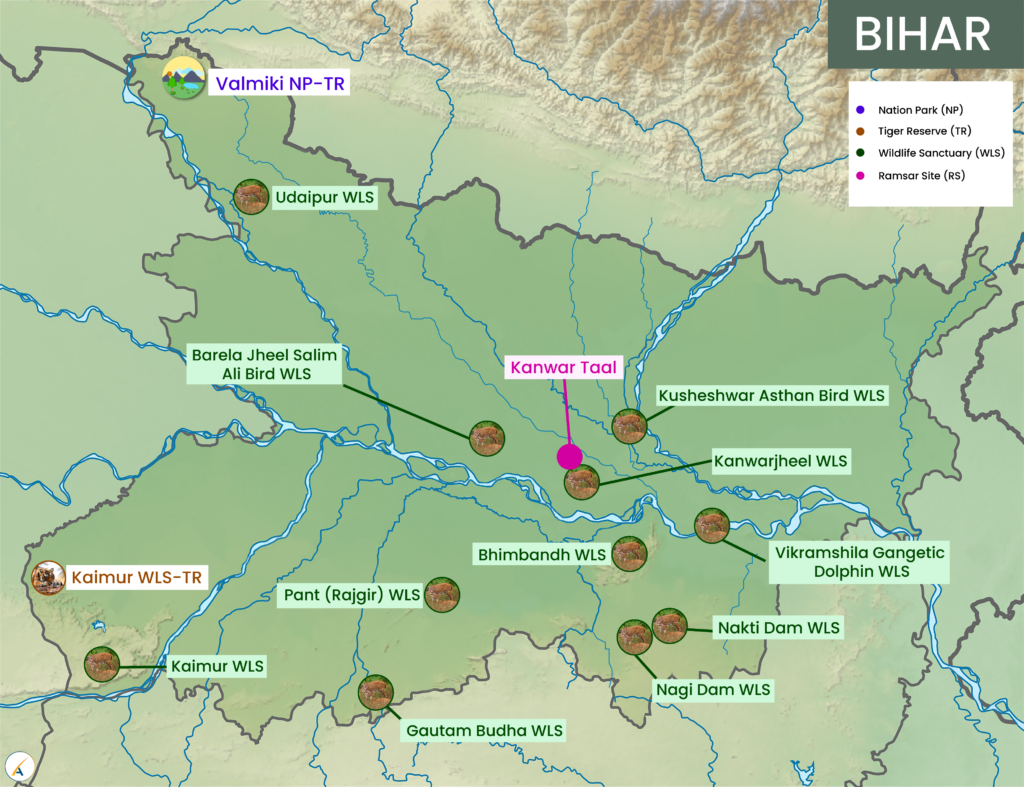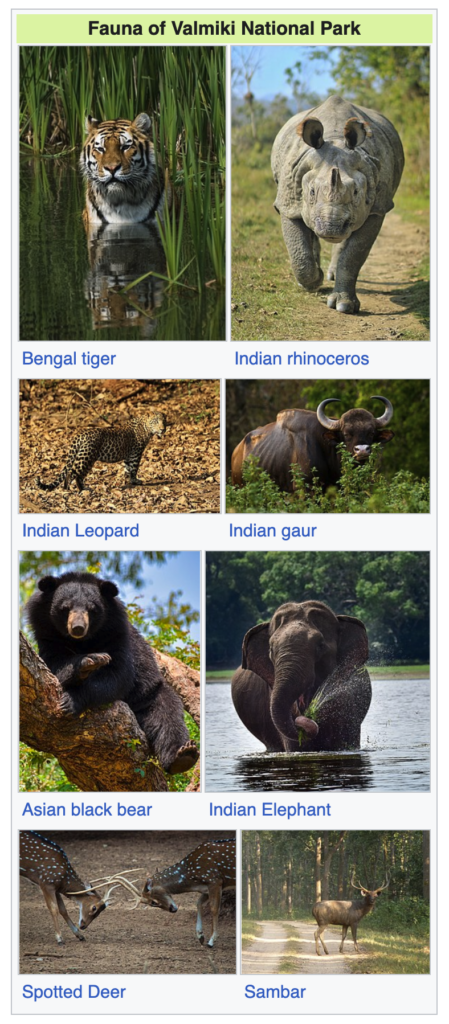Skip to content
Bihar National Parks, Tiger Reserves
Valmiki National Park, Tiger Reserve, Wildlife Sanctuary
Valmiki National Park is a tiger reserve in the West Champaran District of Bihar.
It is located in the foothill ranges of Siwaliks at the Indo-Nepal border . River Gandak ‘Narayani’ in Nepal) forms its western boundary. It is the only National Park in Bihar .
Harha-Masan River system originates from the Valmiki National Park and forms Burhi Gandak River down south.In the north, the protected areas are bordered by Nepal’s Chitwan National Park while the Indian state Uttar Pradesh bounds the sanctuary from western side.
Vegetation: Moist deciduous, semi-evergreen, freshwater swamps, alluvial grasslands, savannah and wetlands.
Major Fauna: Bengal tiger, rhinoceros , Indian flying fox , black bear, sloth bear, leopard, barking deer, spotted deer, hog deer, sambar, clouded Leopard, Indian gaur.
‘Tharu’ , a scheduled tribe, is the dominant community.
Wildlife Sanctuaries of Bihar
Bhimbandh Wildlife Sanctuary
It is situated south of the Ganges River Chota Nagpur Plateau and west of Santhal Pargana .
During the Mahabharata period, when the Pandavas were on their exile, they had also come to this forest during that time.
In the valley portions and at the foothills are several hot springs of which the finest are at Bhimbandh, Sita Kund and Rishi Kund.
Gautam Budha Wildlife Sanctuary
It is located in Gaya district of Bihar and Koderma district of Jharkhand .
Fauna include tigers, leopards, wolves, sloth bears, chitals, chinkaras, and many species of birds.
Kaimur Wildlife Sanctuary
It is located in the eastern part of the Vindhyan Scrap Lands .
It is the Bihar’s largest Wildlife Sanctuary and is a tiger corridor
Rohtasgarh Fort and Shergarh Fort are also located in these forests.The major forest types are Tropical Dry Mixed Deciduous, Dry Sal Forests, Boswellia Forests and Dry Bamboo Brakes.
In the valley portions there are several waterfalls of which the finest are Karkat Waterfall, Manjhar Kund, Dhua Kund, Tutla Bhawani waterfall, Geeta ghat waterfall, Kashish Waterfall, and Telhar .
There are several Dams and lakes, including Anupam Lake, Karamchat dam and Kohira Dam.
Kanwar Jheel Wildlife Sanctuary (BS) (Ramsar Site)
It is Asia’s largest freshwater oxbow lake .
It is larger than the Bharatpur Bird Sanctuary (Keoladeo Ghana National Park, Rajasthan) .
Notable Avifauna: White-backed vulture (CR) & Long-billed (Indian) vulture (CR).
Udaipur Wildlife Sanctuary
Located in West Champaran district of Bihar.
It is an oxbow lake in the floodplain of the Gandaki River .
Vikramshila Gangetic Dolphin Wildlife Sanctuary
It is a 60 km stretch of the Ganges River from Sultanganj to Kahalgaon in Bhagalpur district , Bihar.
It is a protected area for India’s national aquatic animal – Gangetic dolphins (EN) .
Barela Jheel Salim Ali Bird Wildlife Sanctuary
(Salim Ali-Jubba Sahni Bird Sanctuary)
Located in the Vaishali district of Bihar.
Natural home for migratory birds.
Kusheshwar Asthan Bird Wildlife Sanctuary
Close to the right bank of River Kosi (Sorrow of Bihar) and Kanwar Lake.
Kusheshwar Shiva Temple lies nearby from which the name of this place is derived.
Nagi Dam Wildlife Sanctuary & Nakti Dam Wildlife Sanctuary
Bird Sanctuaries in Jamui district . They are located close to each other.
In 2004, Nagi Dam Bird Sanctuary was declared an Important Bird Area (IBA) by BirdLife International.
Pant (Rajgir) Wildlife Sanctuary
Located in the ancient city of Rajgir in Nalanda district, Bihar.
The landscape of Pant Wildlife Sanctuary is uneven terrain enclosed by five mountains – Ratnagiri, Vipulgiri, Vaibhargiri, Songiri and Udaygiri.
Ramsar Sites of Bihar
Kanwar Taal or Kabar Taal Lake
The Kanwar Taal or Kabar Taal Lake or Kabartal Wetland located in Begusarai district of Bihar, India, is Asia’s largest freshwater oxbow lake.
It is the first Ramsar site in Bihar. It lies in the Indo-Gangetic Plain.
It is a residual oxbow lake, formed due to meandering of Burhi Gandak river, a tributary of Ganga , in the geological past.
Once a haven for migratory birds, the Kanwar lake in Bihar, Asia’s largest freshwater oxbow lake, is today a dying wetland ecosystem .
Kanwar Lake was declared a notified area under the Wildlife (Protection) Act of 1972.
Endangered Avifauna: Red-Headed Vulture (CR) , White-Rumped Vulture (CR) , Indian Vulture (CR) – and two waterbirds, the Baer’s Pochard (CR) & Sociable Lapwing (CR) .
wpDiscuz
Insert


